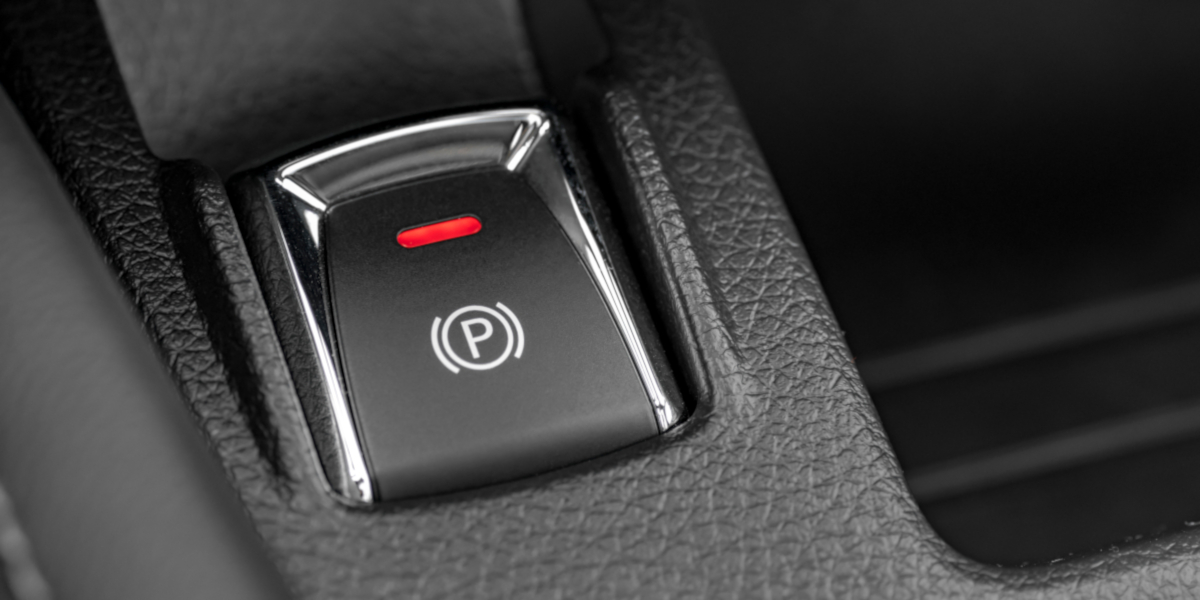Case study of a failure on the electric parking brake system
This failure case study concerning the electric parking brake of a vehicle will give you an exclusive insight into the world of a multi-make auto mechanic using ACTIA’s multi-make diagnostic tool. One of the car’s dashboard lights comes on: “electric parking brake system deactivated”. What should the mechanic do?
The electric parking brake’s function
The electric parking brake is a sophisticated safety device. The function of the parking brake is to immobilise the stationary vehicle. Brake callipers, operated by an electric motor, clamp the wheels of the vehicle. The electric parking brake is activated by a control button located on the car’s dashboard or central console.
When the parking brake is activated, the electronic system automatically adjusts the clamping force necessary to prevent any unexpected vehicle movement. If the vehicle is parked on a slope of more than 30%, a warning appears on the dashboard. When the brake discs cool, the ECU automatically tightens the grip. The ECU has a built-in simulation model which determines the momentary temperature of the brake discs.
The electric parking brake offers many advantages:
- fewer mechanical parts for less maintenance;
- automated braking system;
- hill-start assistance;
- highly efficient emergency braking;
- smart management of malfunctions by the ECU;
- more space in the central area of the vehicle.
The main disadvantage is the complexity of repairing this system. Although maintenance is indeed significantly reduced, electrical malfunctions, which are difficult to resolve, often undermine reliability, and can be costly. ACTIA’s Multi-Diag guides the mechanic through the repair of the electric brake.
Step-by-step diagnosis of the electric parking brake
The Express Diag function: Detect the failure in a single click
Multi-Diag 360 reports a fault on the electric parking brake ECU once the Express Diag function has been activated. This ACTIA-invented function takes the form of a short-cut button on the diagnostic tool. It enables the auto mechanic to query all the ECUs in a single click, in order to identify even the slightest ECU fault.
A failure listed in the Multi-Diag library
The failure is already listed among the 980,000 failure cases in the Multi-Diag failure library. This is therefore a failure identified and resolved by ACTIA’s online assistance. The mechanic thus benefits from the experience of the worldwide Multi-Diag user community. Failure cases and solutions are added to the database every day. Searches can be conducted by symptom or fault code.
Access to technical documentation is also available, to enable the repair professional to locate the different components of the system in question. The repair professional therefore has plenty of support when looking for the failure. He or she is guided in the diagnosis.
Using Multi-Diag 360’s parameter measurements and actuator tests, the technician can ensure that the main components are functioning correctly, such as the brake pedal switch or the electric parking brake switch, etc.
An ECU software update is required
In our failure case, after trying to clear the fault code, the problem persists. This confirms the case study hypothesis associated with this fault code: the repair professional must update the software of the ECU! This means the mechanic must open the program that the manufacturer downloaded to the electric parking brake ECU in order to update it and restart the program in good working order. However, only the diagnostic tools from the manufacturer of the make in question are authorised to perform ECU updates. Multi-make tools alone cannot perform this type of operation. The technician therefore requires access to the manufacturer’s diagnostic tool. There are two possible methods.
The two possible repair solutions for the electric parking brake
Solution #1: Download the manufacturer’s tool
The Multi-Diag VCI satisfies the PassThru standard. Operators can therefore update the ECU responsible for the failure themselves. They will need to download the manufacturer’s tool from its diagnostic platform.
This operation is quite complicated in practice and is time-consuming for the repair professional.
There are several steps to the process:
- software installation;
- apply for registration;
- satisfy the manufacturer’s specific criteria;
- and finally, configure the program.
All these steps can sometimes take several weeks.
Read: “The winning trio of automobile ECU reprogramming”
Solution #2: Use the ACTIA platform
Using ACTIA’s PRP (PassThru Remote Platform), the mechanic is assisted in real time by an expert technician. The expert remotely connects to the mechanic’s PassThru interface. PRP is a remote-control platform on the PassThru VCI connected to the vehicle in order to update one or more ECUs that have undergone work. This is the case with our electric parking brake failure. ACTIA assistance naturally performs this ECU update using the manufacturer’s diagnostic tool.
This offers many benefits to the repair professional:
- an immediate solution: none of the delays sometimes incurred by the manufacturer’s procedure;
- vehicles are immobilised for a shorter period of time in the workshop, boosting customer satisfaction;
- installation of the platform on the auto mechanic’s tool is simple and intuitive, just like Multi-Diag.
With ACTIA’s PRP, the mechanic can quickly and easily repair the parking brake failure, like all the other listed failures requiring ECU reprogramming.
Key points:
- Express Diag;
- Case studies;
- Guided method;
- Technical documentation;
- Online catalogue of spare parts;
- PassThru VCI;
- The PRP.
ACTIA’s Multi-Diag has everything aftermarket and repair professionals need to service the latest vehicles, to widen their expertise and to enhance customer loyalty.
Important:
The technical information, tips and practical tips presented in this article are intended for auto repair professionals in the course of their activities. All information made available in this content is intended to be used only by duly qualified professionals.






